Organizational Behaviour and Leadership: A Case Study of IKEA
VerifiedAdded on 2021/01/02
|12
|3055
|251
Report
AI Summary
This report provides an in-depth analysis of organizational behaviour, focusing on the application of various theories within the context of IKEA. It begins with definitions of key concepts such as motivation to work, change management, and leadership. The report then explores prominent theories within each of these areas, including Maslow's Hierarchy of Needs and Hertzberg's Two-Factor Theory for motivation, McKinsey's 7-S Model and Kotter's 8-Step Model for change management, and Trait Theory and Behavioral Theory for leadership. The report outlines the relationship of each theory to IKEA's organizational practices. Finally, the report examines how these theories are applied within IKEA, discussing intrinsic and extrinsic motivation factors, the importance of change management for employee development and market competitiveness, and the role of leadership in building strong teams and achieving organizational goals. The report concludes by emphasizing the importance of these theories for IKEA's success.
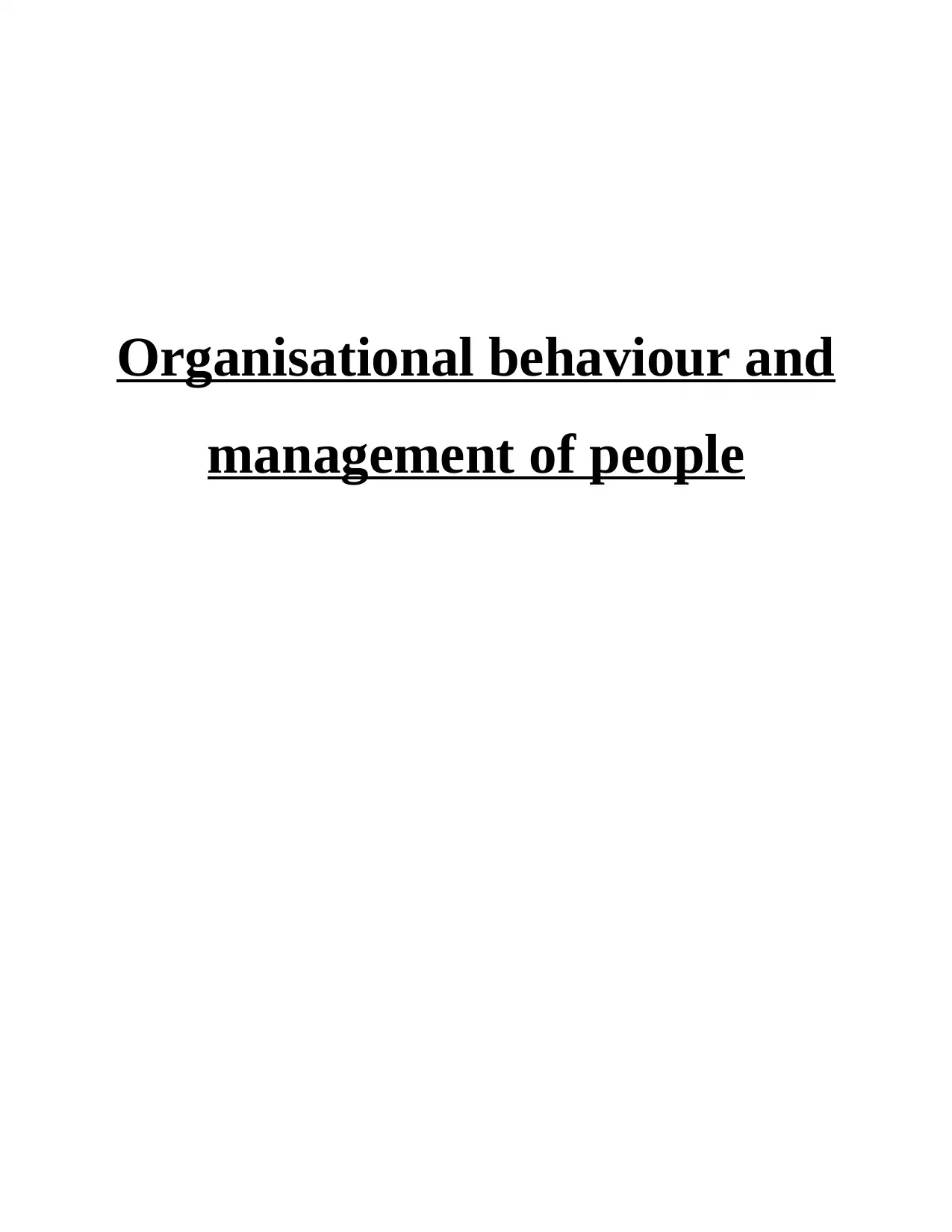
Organisational behaviour and
management of people
management of people
Paraphrase This Document
Need a fresh take? Get an instant paraphrase of this document with our AI Paraphraser
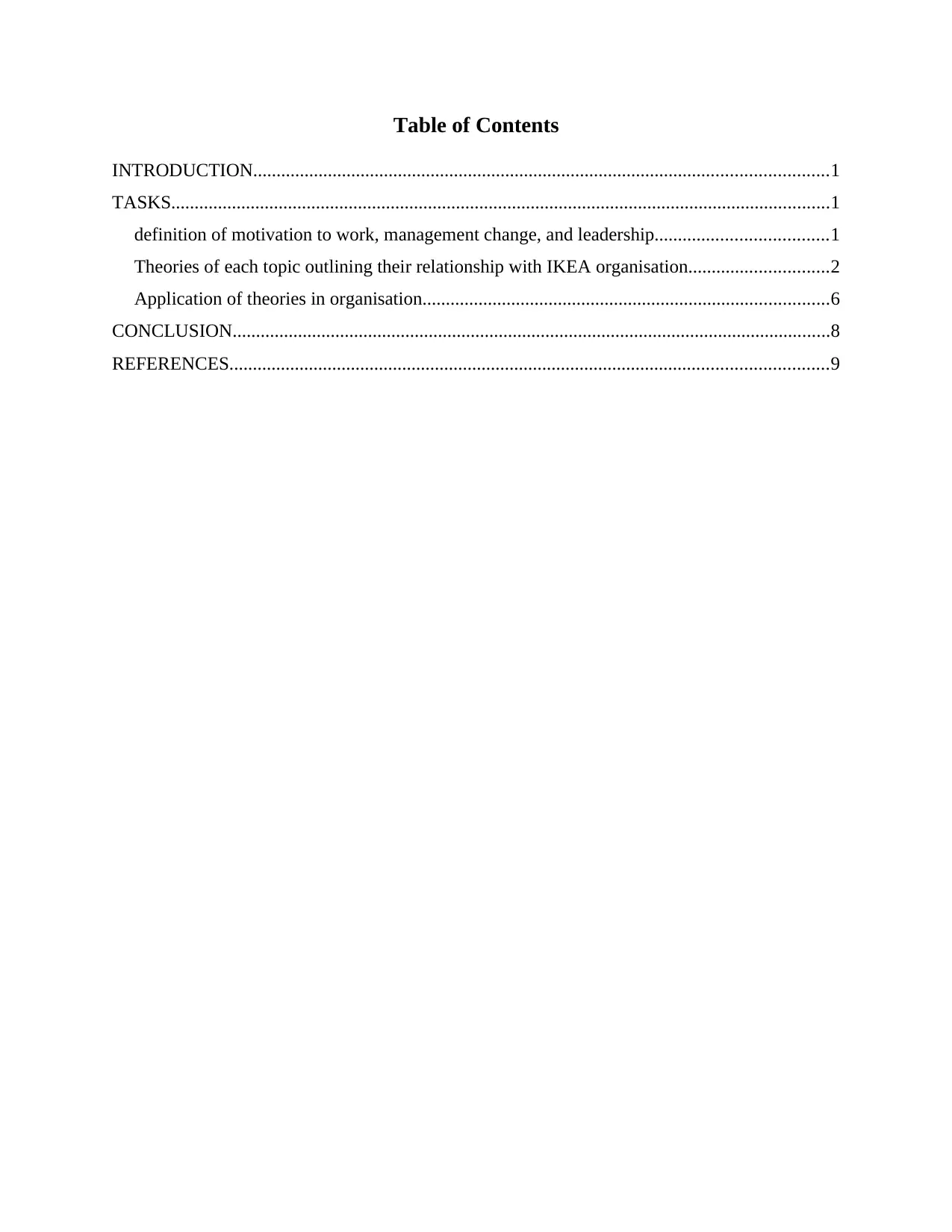
Table of Contents
INTRODUCTION...........................................................................................................................1
TASKS.............................................................................................................................................1
definition of motivation to work, management change, and leadership.....................................1
Theories of each topic outlining their relationship with IKEA organisation..............................2
Application of theories in organisation.......................................................................................6
CONCLUSION................................................................................................................................8
REFERENCES................................................................................................................................9
INTRODUCTION...........................................................................................................................1
TASKS.............................................................................................................................................1
definition of motivation to work, management change, and leadership.....................................1
Theories of each topic outlining their relationship with IKEA organisation..............................2
Application of theories in organisation.......................................................................................6
CONCLUSION................................................................................................................................8
REFERENCES................................................................................................................................9
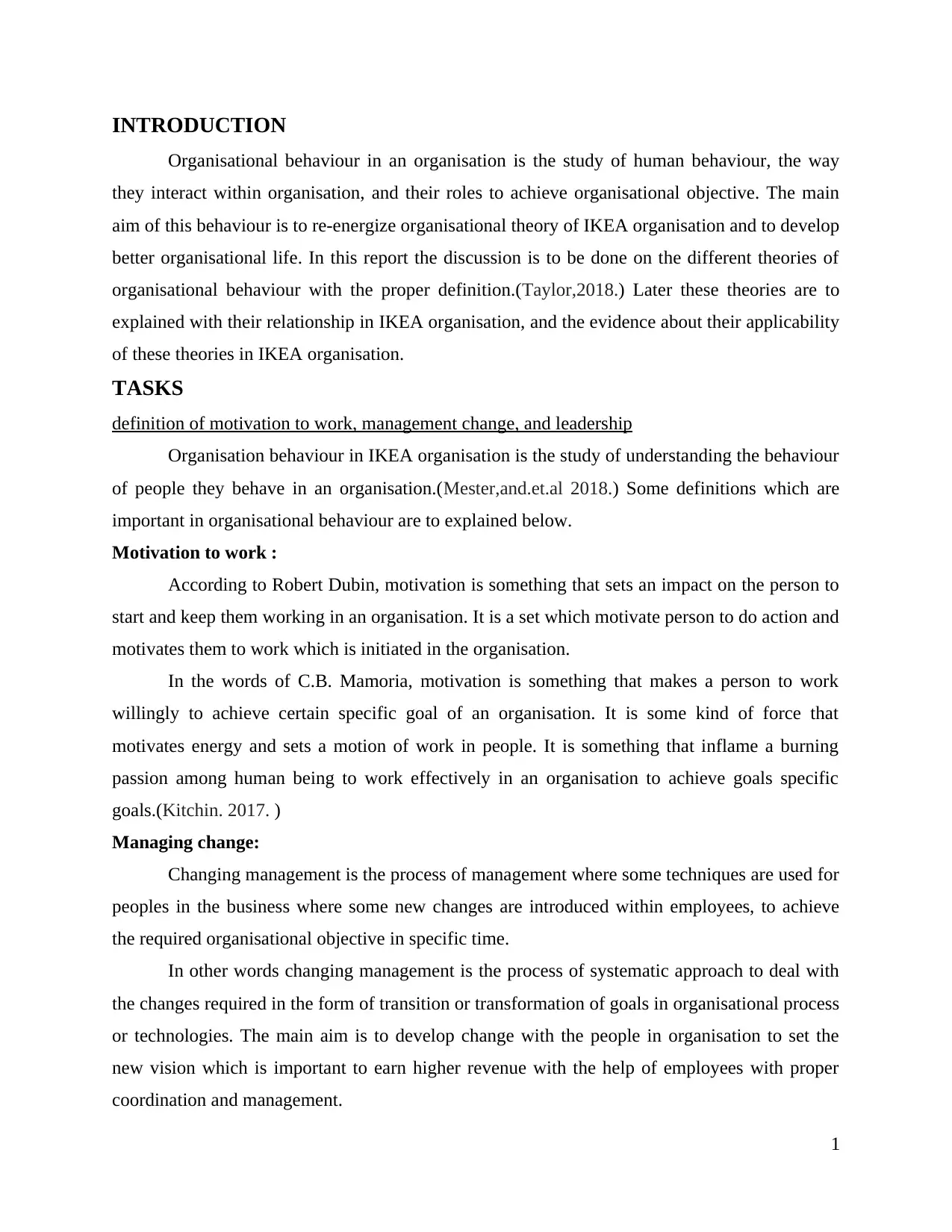
INTRODUCTION
Organisational behaviour in an organisation is the study of human behaviour, the way
they interact within organisation, and their roles to achieve organisational objective. The main
aim of this behaviour is to re-energize organisational theory of IKEA organisation and to develop
better organisational life. In this report the discussion is to be done on the different theories of
organisational behaviour with the proper definition.(Taylor,2018.) Later these theories are to
explained with their relationship in IKEA organisation, and the evidence about their applicability
of these theories in IKEA organisation.
TASKS
definition of motivation to work, management change, and leadership
Organisation behaviour in IKEA organisation is the study of understanding the behaviour
of people they behave in an organisation.(Mester,and.et.al 2018.) Some definitions which are
important in organisational behaviour are to explained below.
Motivation to work :
According to Robert Dubin, motivation is something that sets an impact on the person to
start and keep them working in an organisation. It is a set which motivate person to do action and
motivates them to work which is initiated in the organisation.
In the words of C.B. Mamoria, motivation is something that makes a person to work
willingly to achieve certain specific goal of an organisation. It is some kind of force that
motivates energy and sets a motion of work in people. It is something that inflame a burning
passion among human being to work effectively in an organisation to achieve goals specific
goals.(Kitchin. 2017. )
Managing change:
Changing management is the process of management where some techniques are used for
peoples in the business where some new changes are introduced within employees, to achieve
the required organisational objective in specific time.
In other words changing management is the process of systematic approach to deal with
the changes required in the form of transition or transformation of goals in organisational process
or technologies. The main aim is to develop change with the people in organisation to set the
new vision which is important to earn higher revenue with the help of employees with proper
coordination and management.
1
Organisational behaviour in an organisation is the study of human behaviour, the way
they interact within organisation, and their roles to achieve organisational objective. The main
aim of this behaviour is to re-energize organisational theory of IKEA organisation and to develop
better organisational life. In this report the discussion is to be done on the different theories of
organisational behaviour with the proper definition.(Taylor,2018.) Later these theories are to
explained with their relationship in IKEA organisation, and the evidence about their applicability
of these theories in IKEA organisation.
TASKS
definition of motivation to work, management change, and leadership
Organisation behaviour in IKEA organisation is the study of understanding the behaviour
of people they behave in an organisation.(Mester,and.et.al 2018.) Some definitions which are
important in organisational behaviour are to explained below.
Motivation to work :
According to Robert Dubin, motivation is something that sets an impact on the person to
start and keep them working in an organisation. It is a set which motivate person to do action and
motivates them to work which is initiated in the organisation.
In the words of C.B. Mamoria, motivation is something that makes a person to work
willingly to achieve certain specific goal of an organisation. It is some kind of force that
motivates energy and sets a motion of work in people. It is something that inflame a burning
passion among human being to work effectively in an organisation to achieve goals specific
goals.(Kitchin. 2017. )
Managing change:
Changing management is the process of management where some techniques are used for
peoples in the business where some new changes are introduced within employees, to achieve
the required organisational objective in specific time.
In other words changing management is the process of systematic approach to deal with
the changes required in the form of transition or transformation of goals in organisational process
or technologies. The main aim is to develop change with the people in organisation to set the
new vision which is important to earn higher revenue with the help of employees with proper
coordination and management.
1
⊘ This is a preview!⊘
Do you want full access?
Subscribe today to unlock all pages.

Trusted by 1+ million students worldwide
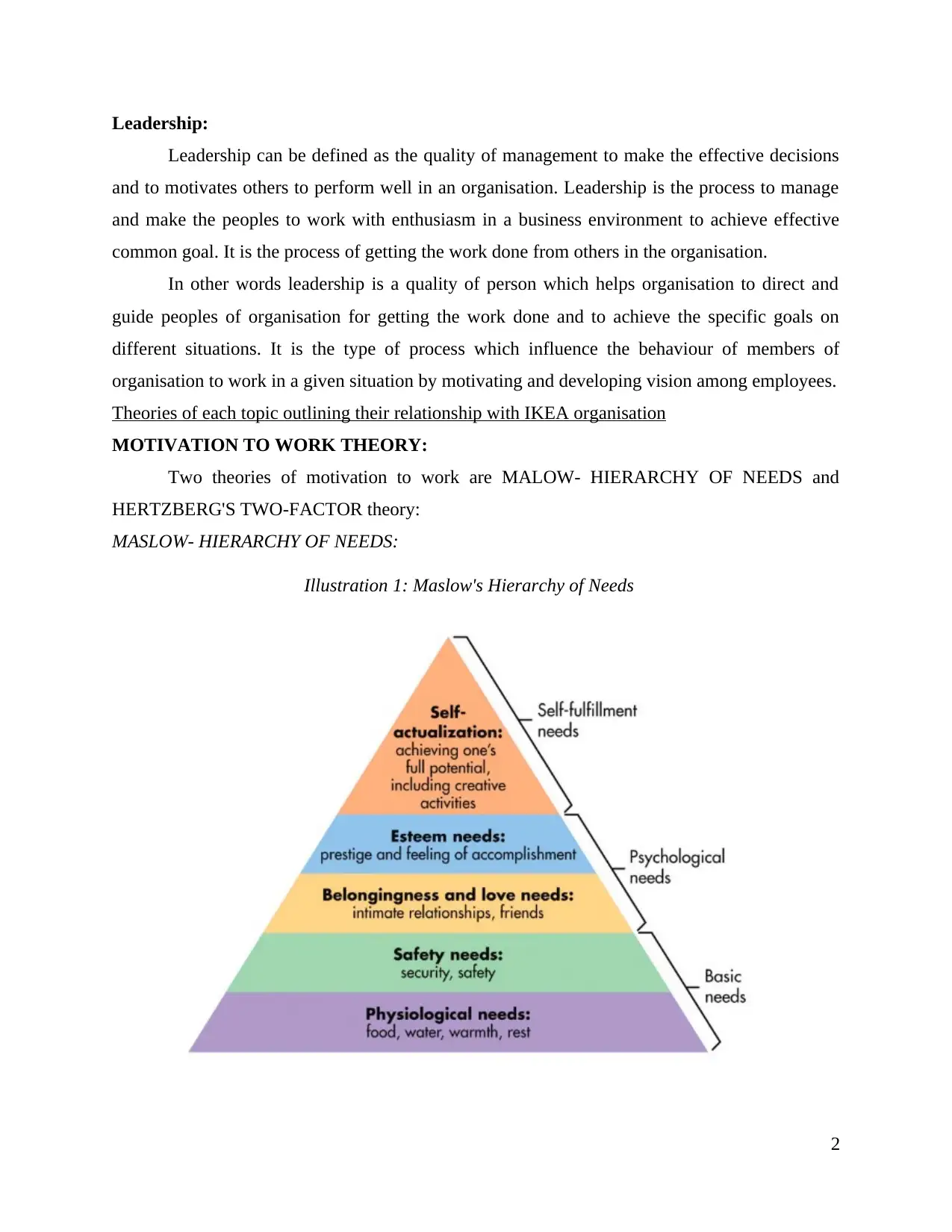
Leadership:
Leadership can be defined as the quality of management to make the effective decisions
and to motivates others to perform well in an organisation. Leadership is the process to manage
and make the peoples to work with enthusiasm in a business environment to achieve effective
common goal. It is the process of getting the work done from others in the organisation.
In other words leadership is a quality of person which helps organisation to direct and
guide peoples of organisation for getting the work done and to achieve the specific goals on
different situations. It is the type of process which influence the behaviour of members of
organisation to work in a given situation by motivating and developing vision among employees.
Theories of each topic outlining their relationship with IKEA organisation
MOTIVATION TO WORK THEORY:
Two theories of motivation to work are MALOW- HIERARCHY OF NEEDS and
HERTZBERG'S TWO-FACTOR theory:
MASLOW- HIERARCHY OF NEEDS:
2
Illustration 1: Maslow's Hierarchy of Needs
source:(.Maslow's Hierarchy of Needs,2018)
Leadership can be defined as the quality of management to make the effective decisions
and to motivates others to perform well in an organisation. Leadership is the process to manage
and make the peoples to work with enthusiasm in a business environment to achieve effective
common goal. It is the process of getting the work done from others in the organisation.
In other words leadership is a quality of person which helps organisation to direct and
guide peoples of organisation for getting the work done and to achieve the specific goals on
different situations. It is the type of process which influence the behaviour of members of
organisation to work in a given situation by motivating and developing vision among employees.
Theories of each topic outlining their relationship with IKEA organisation
MOTIVATION TO WORK THEORY:
Two theories of motivation to work are MALOW- HIERARCHY OF NEEDS and
HERTZBERG'S TWO-FACTOR theory:
MASLOW- HIERARCHY OF NEEDS:
2
Illustration 1: Maslow's Hierarchy of Needs
source:(.Maslow's Hierarchy of Needs,2018)
Paraphrase This Document
Need a fresh take? Get an instant paraphrase of this document with our AI Paraphraser
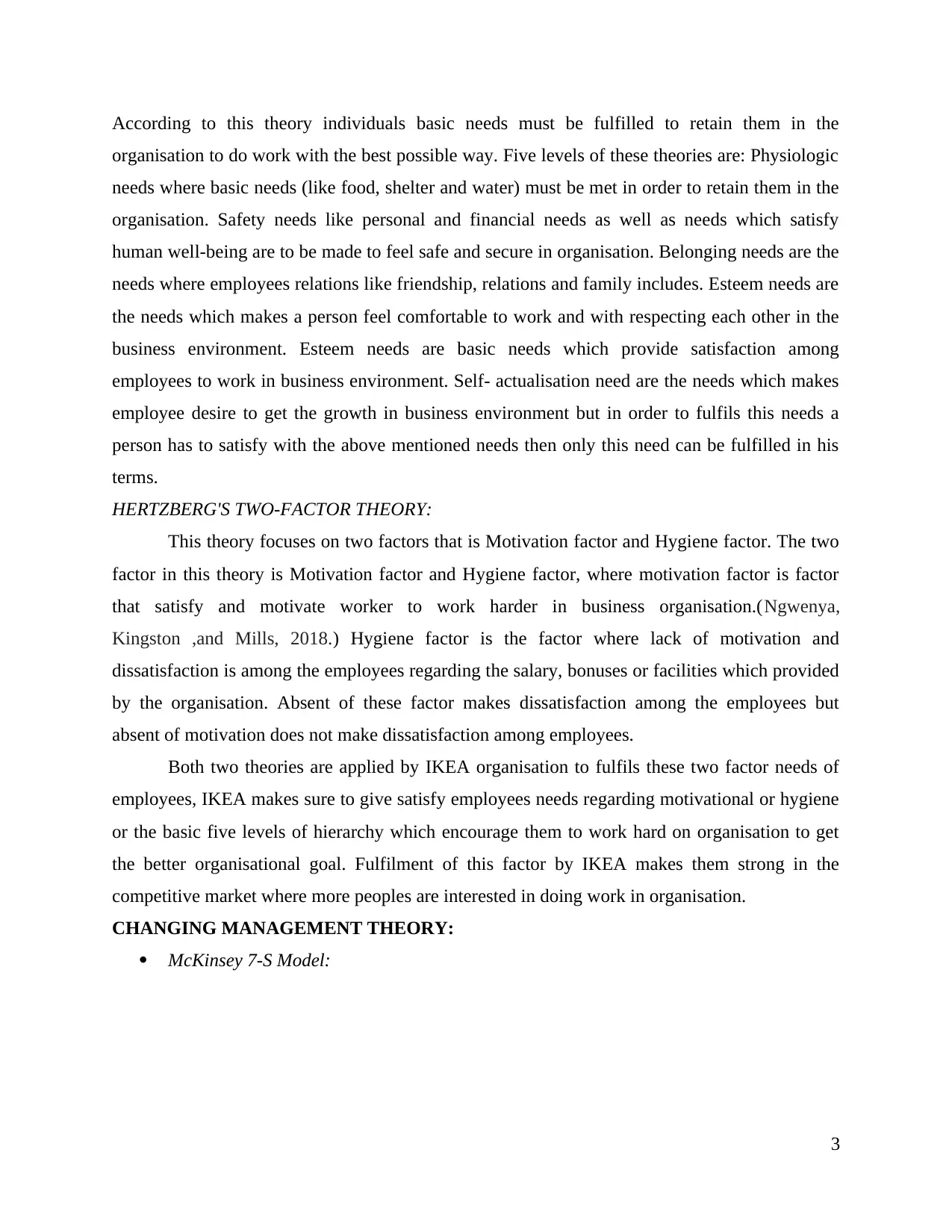
According to this theory individuals basic needs must be fulfilled to retain them in the
organisation to do work with the best possible way. Five levels of these theories are: Physiologic
needs where basic needs (like food, shelter and water) must be met in order to retain them in the
organisation. Safety needs like personal and financial needs as well as needs which satisfy
human well-being are to be made to feel safe and secure in organisation. Belonging needs are the
needs where employees relations like friendship, relations and family includes. Esteem needs are
the needs which makes a person feel comfortable to work and with respecting each other in the
business environment. Esteem needs are basic needs which provide satisfaction among
employees to work in business environment. Self- actualisation need are the needs which makes
employee desire to get the growth in business environment but in order to fulfils this needs a
person has to satisfy with the above mentioned needs then only this need can be fulfilled in his
terms.
HERTZBERG'S TWO-FACTOR THEORY:
This theory focuses on two factors that is Motivation factor and Hygiene factor. The two
factor in this theory is Motivation factor and Hygiene factor, where motivation factor is factor
that satisfy and motivate worker to work harder in business organisation.(Ngwenya,
Kingston ,and Mills, 2018.) Hygiene factor is the factor where lack of motivation and
dissatisfaction is among the employees regarding the salary, bonuses or facilities which provided
by the organisation. Absent of these factor makes dissatisfaction among the employees but
absent of motivation does not make dissatisfaction among employees.
Both two theories are applied by IKEA organisation to fulfils these two factor needs of
employees, IKEA makes sure to give satisfy employees needs regarding motivational or hygiene
or the basic five levels of hierarchy which encourage them to work hard on organisation to get
the better organisational goal. Fulfilment of this factor by IKEA makes them strong in the
competitive market where more peoples are interested in doing work in organisation.
CHANGING MANAGEMENT THEORY:
McKinsey 7-S Model:
3
organisation to do work with the best possible way. Five levels of these theories are: Physiologic
needs where basic needs (like food, shelter and water) must be met in order to retain them in the
organisation. Safety needs like personal and financial needs as well as needs which satisfy
human well-being are to be made to feel safe and secure in organisation. Belonging needs are the
needs where employees relations like friendship, relations and family includes. Esteem needs are
the needs which makes a person feel comfortable to work and with respecting each other in the
business environment. Esteem needs are basic needs which provide satisfaction among
employees to work in business environment. Self- actualisation need are the needs which makes
employee desire to get the growth in business environment but in order to fulfils this needs a
person has to satisfy with the above mentioned needs then only this need can be fulfilled in his
terms.
HERTZBERG'S TWO-FACTOR THEORY:
This theory focuses on two factors that is Motivation factor and Hygiene factor. The two
factor in this theory is Motivation factor and Hygiene factor, where motivation factor is factor
that satisfy and motivate worker to work harder in business organisation.(Ngwenya,
Kingston ,and Mills, 2018.) Hygiene factor is the factor where lack of motivation and
dissatisfaction is among the employees regarding the salary, bonuses or facilities which provided
by the organisation. Absent of these factor makes dissatisfaction among the employees but
absent of motivation does not make dissatisfaction among employees.
Both two theories are applied by IKEA organisation to fulfils these two factor needs of
employees, IKEA makes sure to give satisfy employees needs regarding motivational or hygiene
or the basic five levels of hierarchy which encourage them to work hard on organisation to get
the better organisational goal. Fulfilment of this factor by IKEA makes them strong in the
competitive market where more peoples are interested in doing work in organisation.
CHANGING MANAGEMENT THEORY:
McKinsey 7-S Model:
3
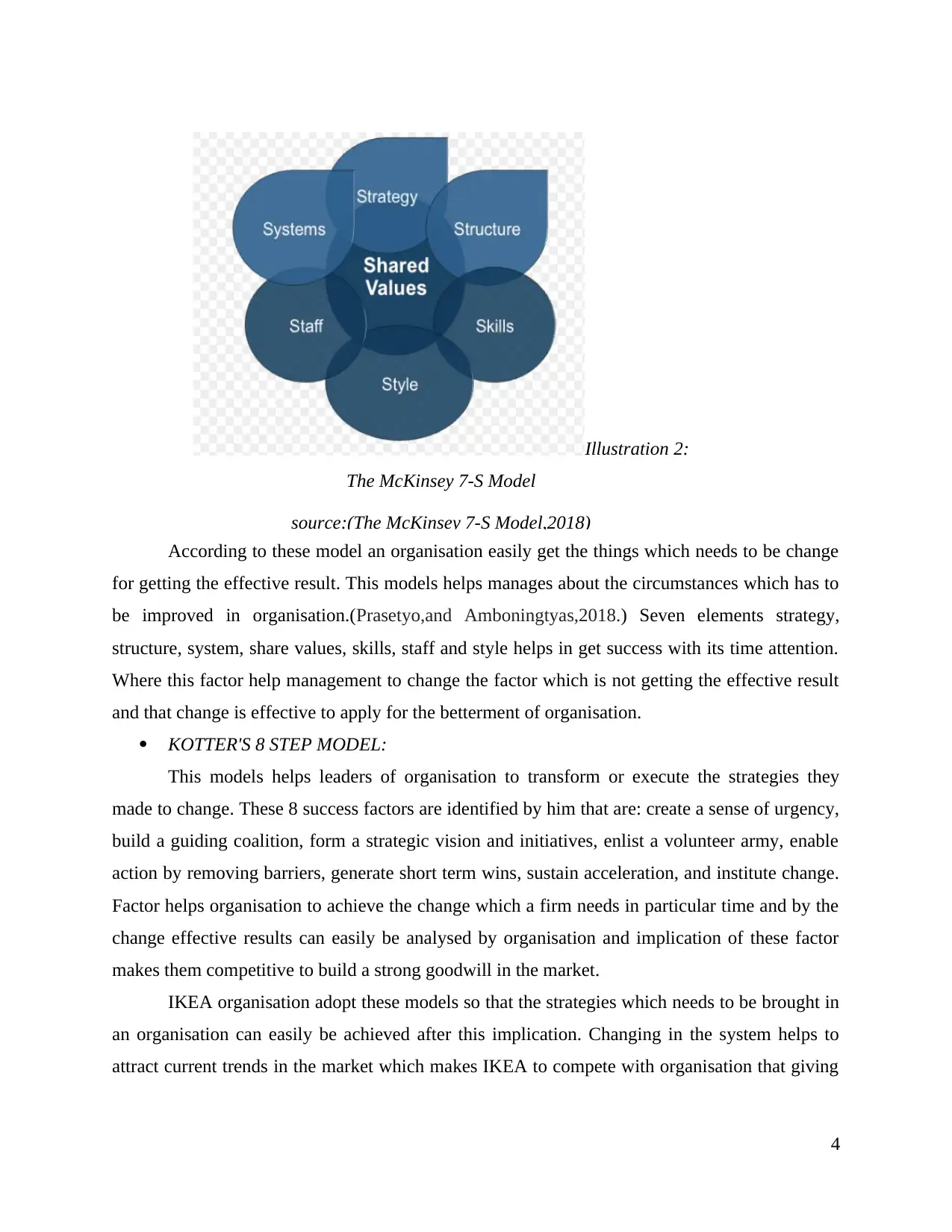
According to these model an organisation easily get the things which needs to be change
for getting the effective result. This models helps manages about the circumstances which has to
be improved in organisation.(Prasetyo,and Amboningtyas,2018.) Seven elements strategy,
structure, system, share values, skills, staff and style helps in get success with its time attention.
Where this factor help management to change the factor which is not getting the effective result
and that change is effective to apply for the betterment of organisation.
KOTTER'S 8 STEP MODEL:
This models helps leaders of organisation to transform or execute the strategies they
made to change. These 8 success factors are identified by him that are: create a sense of urgency,
build a guiding coalition, form a strategic vision and initiatives, enlist a volunteer army, enable
action by removing barriers, generate short term wins, sustain acceleration, and institute change.
Factor helps organisation to achieve the change which a firm needs in particular time and by the
change effective results can easily be analysed by organisation and implication of these factor
makes them competitive to build a strong goodwill in the market.
IKEA organisation adopt these models so that the strategies which needs to be brought in
an organisation can easily be achieved after this implication. Changing in the system helps to
attract current trends in the market which makes IKEA to compete with organisation that giving
4
Illustration 2:
The McKinsey 7-S Model
source:(The McKinsey 7-S Model,2018)
for getting the effective result. This models helps manages about the circumstances which has to
be improved in organisation.(Prasetyo,and Amboningtyas,2018.) Seven elements strategy,
structure, system, share values, skills, staff and style helps in get success with its time attention.
Where this factor help management to change the factor which is not getting the effective result
and that change is effective to apply for the betterment of organisation.
KOTTER'S 8 STEP MODEL:
This models helps leaders of organisation to transform or execute the strategies they
made to change. These 8 success factors are identified by him that are: create a sense of urgency,
build a guiding coalition, form a strategic vision and initiatives, enlist a volunteer army, enable
action by removing barriers, generate short term wins, sustain acceleration, and institute change.
Factor helps organisation to achieve the change which a firm needs in particular time and by the
change effective results can easily be analysed by organisation and implication of these factor
makes them competitive to build a strong goodwill in the market.
IKEA organisation adopt these models so that the strategies which needs to be brought in
an organisation can easily be achieved after this implication. Changing in the system helps to
attract current trends in the market which makes IKEA to compete with organisation that giving
4
Illustration 2:
The McKinsey 7-S Model
source:(The McKinsey 7-S Model,2018)
⊘ This is a preview!⊘
Do you want full access?
Subscribe today to unlock all pages.

Trusted by 1+ million students worldwide
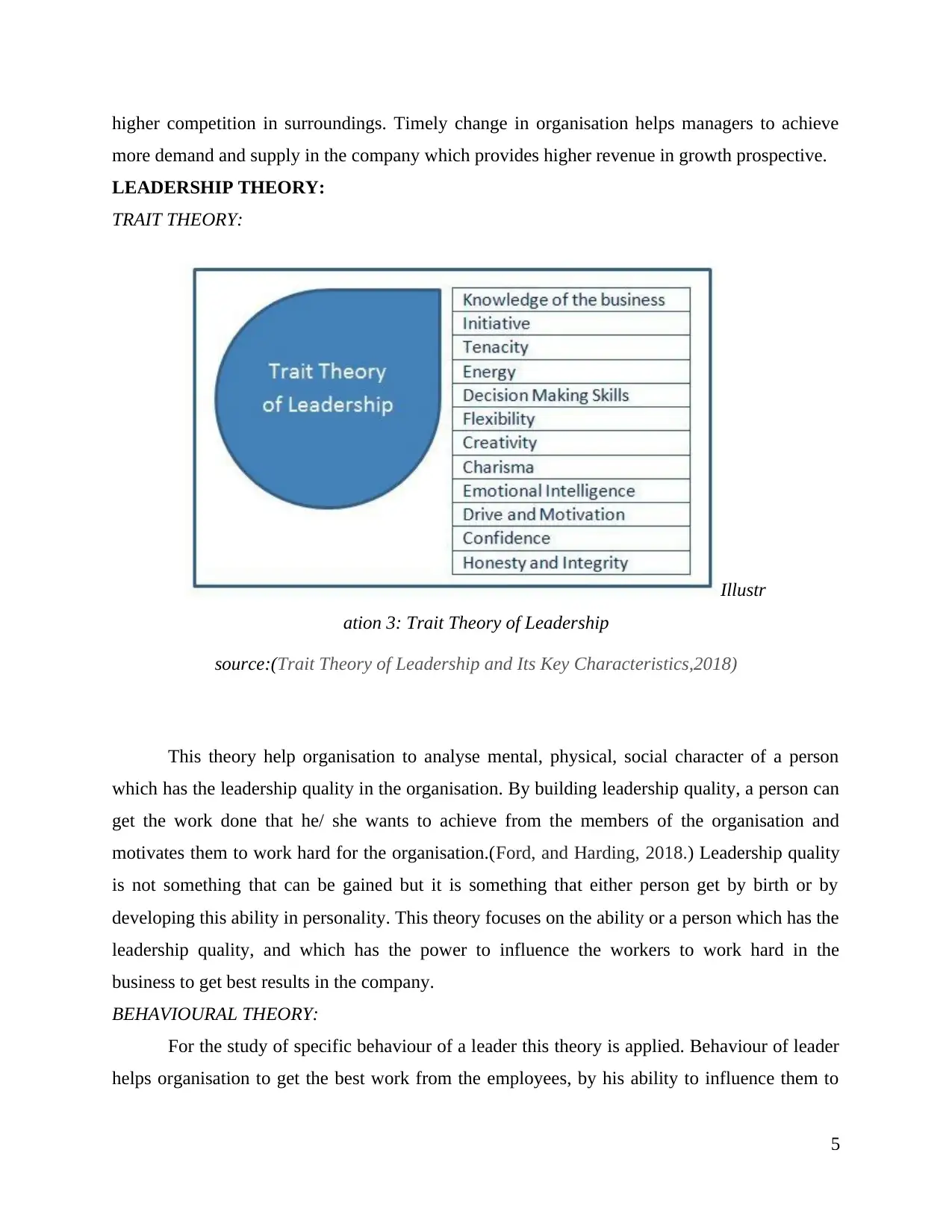
higher competition in surroundings. Timely change in organisation helps managers to achieve
more demand and supply in the company which provides higher revenue in growth prospective.
LEADERSHIP THEORY:
TRAIT THEORY:
This theory help organisation to analyse mental, physical, social character of a person
which has the leadership quality in the organisation. By building leadership quality, a person can
get the work done that he/ she wants to achieve from the members of the organisation and
motivates them to work hard for the organisation.(Ford, and Harding, 2018.) Leadership quality
is not something that can be gained but it is something that either person get by birth or by
developing this ability in personality. This theory focuses on the ability or a person which has the
leadership quality, and which has the power to influence the workers to work hard in the
business to get best results in the company.
BEHAVIOURAL THEORY:
For the study of specific behaviour of a leader this theory is applied. Behaviour of leader
helps organisation to get the best work from the employees, by his ability to influence them to
5
Illustr
ation 3: Trait Theory of Leadership
source:(Trait Theory of Leadership and Its Key Characteristics,2018)
more demand and supply in the company which provides higher revenue in growth prospective.
LEADERSHIP THEORY:
TRAIT THEORY:
This theory help organisation to analyse mental, physical, social character of a person
which has the leadership quality in the organisation. By building leadership quality, a person can
get the work done that he/ she wants to achieve from the members of the organisation and
motivates them to work hard for the organisation.(Ford, and Harding, 2018.) Leadership quality
is not something that can be gained but it is something that either person get by birth or by
developing this ability in personality. This theory focuses on the ability or a person which has the
leadership quality, and which has the power to influence the workers to work hard in the
business to get best results in the company.
BEHAVIOURAL THEORY:
For the study of specific behaviour of a leader this theory is applied. Behaviour of leader
helps organisation to get the best work from the employees, by his ability to influence them to
5
Illustr
ation 3: Trait Theory of Leadership
source:(Trait Theory of Leadership and Its Key Characteristics,2018)
Paraphrase This Document
Need a fresh take? Get an instant paraphrase of this document with our AI Paraphraser
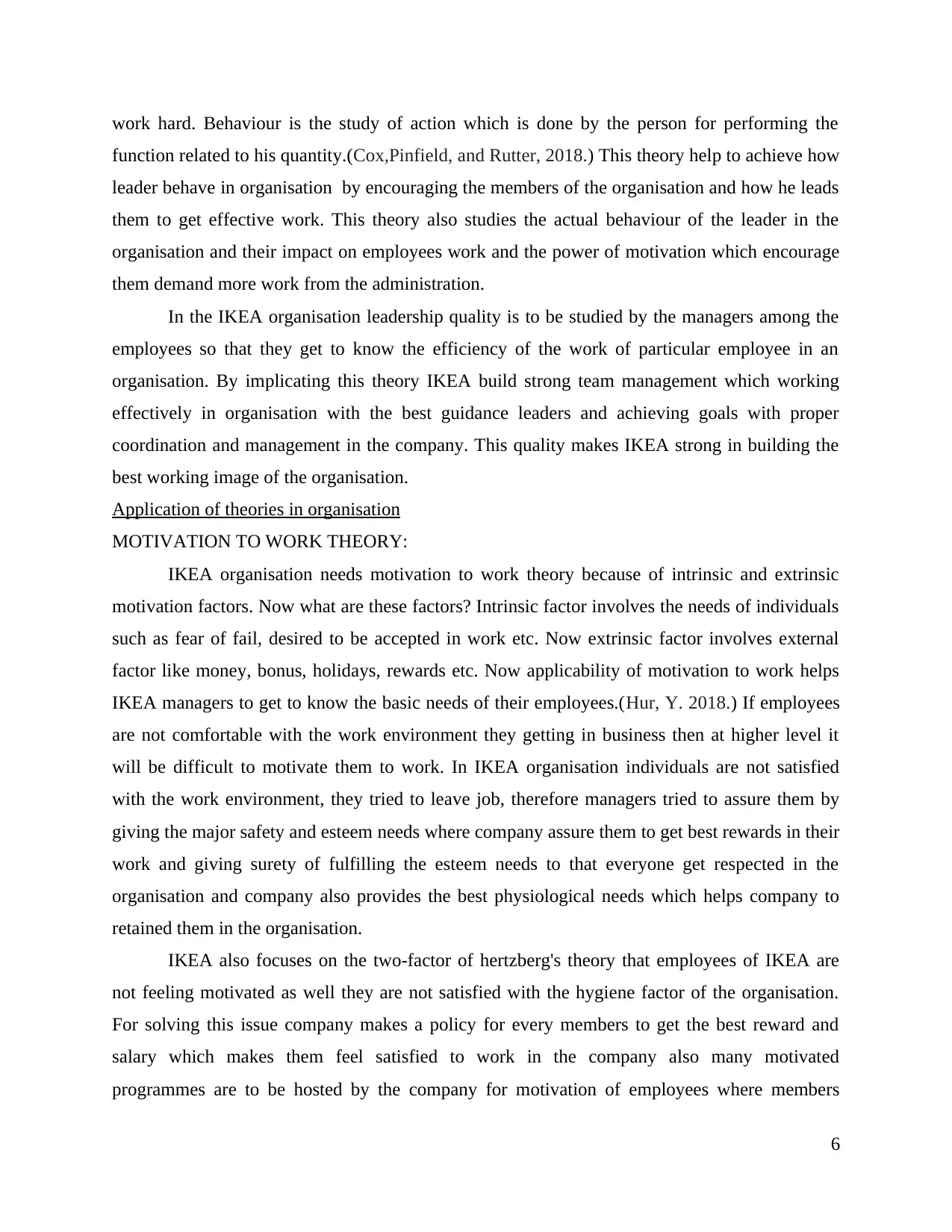
work hard. Behaviour is the study of action which is done by the person for performing the
function related to his quantity.(Cox,Pinfield, and Rutter, 2018.) This theory help to achieve how
leader behave in organisation by encouraging the members of the organisation and how he leads
them to get effective work. This theory also studies the actual behaviour of the leader in the
organisation and their impact on employees work and the power of motivation which encourage
them demand more work from the administration.
In the IKEA organisation leadership quality is to be studied by the managers among the
employees so that they get to know the efficiency of the work of particular employee in an
organisation. By implicating this theory IKEA build strong team management which working
effectively in organisation with the best guidance leaders and achieving goals with proper
coordination and management in the company. This quality makes IKEA strong in building the
best working image of the organisation.
Application of theories in organisation
MOTIVATION TO WORK THEORY:
IKEA organisation needs motivation to work theory because of intrinsic and extrinsic
motivation factors. Now what are these factors? Intrinsic factor involves the needs of individuals
such as fear of fail, desired to be accepted in work etc. Now extrinsic factor involves external
factor like money, bonus, holidays, rewards etc. Now applicability of motivation to work helps
IKEA managers to get to know the basic needs of their employees.(Hur, Y. 2018.) If employees
are not comfortable with the work environment they getting in business then at higher level it
will be difficult to motivate them to work. In IKEA organisation individuals are not satisfied
with the work environment, they tried to leave job, therefore managers tried to assure them by
giving the major safety and esteem needs where company assure them to get best rewards in their
work and giving surety of fulfilling the esteem needs to that everyone get respected in the
organisation and company also provides the best physiological needs which helps company to
retained them in the organisation.
IKEA also focuses on the two-factor of hertzberg's theory that employees of IKEA are
not feeling motivated as well they are not satisfied with the hygiene factor of the organisation.
For solving this issue company makes a policy for every members to get the best reward and
salary which makes them feel satisfied to work in the company also many motivated
programmes are to be hosted by the company for motivation of employees where members
6
function related to his quantity.(Cox,Pinfield, and Rutter, 2018.) This theory help to achieve how
leader behave in organisation by encouraging the members of the organisation and how he leads
them to get effective work. This theory also studies the actual behaviour of the leader in the
organisation and their impact on employees work and the power of motivation which encourage
them demand more work from the administration.
In the IKEA organisation leadership quality is to be studied by the managers among the
employees so that they get to know the efficiency of the work of particular employee in an
organisation. By implicating this theory IKEA build strong team management which working
effectively in organisation with the best guidance leaders and achieving goals with proper
coordination and management in the company. This quality makes IKEA strong in building the
best working image of the organisation.
Application of theories in organisation
MOTIVATION TO WORK THEORY:
IKEA organisation needs motivation to work theory because of intrinsic and extrinsic
motivation factors. Now what are these factors? Intrinsic factor involves the needs of individuals
such as fear of fail, desired to be accepted in work etc. Now extrinsic factor involves external
factor like money, bonus, holidays, rewards etc. Now applicability of motivation to work helps
IKEA managers to get to know the basic needs of their employees.(Hur, Y. 2018.) If employees
are not comfortable with the work environment they getting in business then at higher level it
will be difficult to motivate them to work. In IKEA organisation individuals are not satisfied
with the work environment, they tried to leave job, therefore managers tried to assure them by
giving the major safety and esteem needs where company assure them to get best rewards in their
work and giving surety of fulfilling the esteem needs to that everyone get respected in the
organisation and company also provides the best physiological needs which helps company to
retained them in the organisation.
IKEA also focuses on the two-factor of hertzberg's theory that employees of IKEA are
not feeling motivated as well they are not satisfied with the hygiene factor of the organisation.
For solving this issue company makes a policy for every members to get the best reward and
salary which makes them feel satisfied to work in the company also many motivated
programmes are to be hosted by the company for motivation of employees where members
6
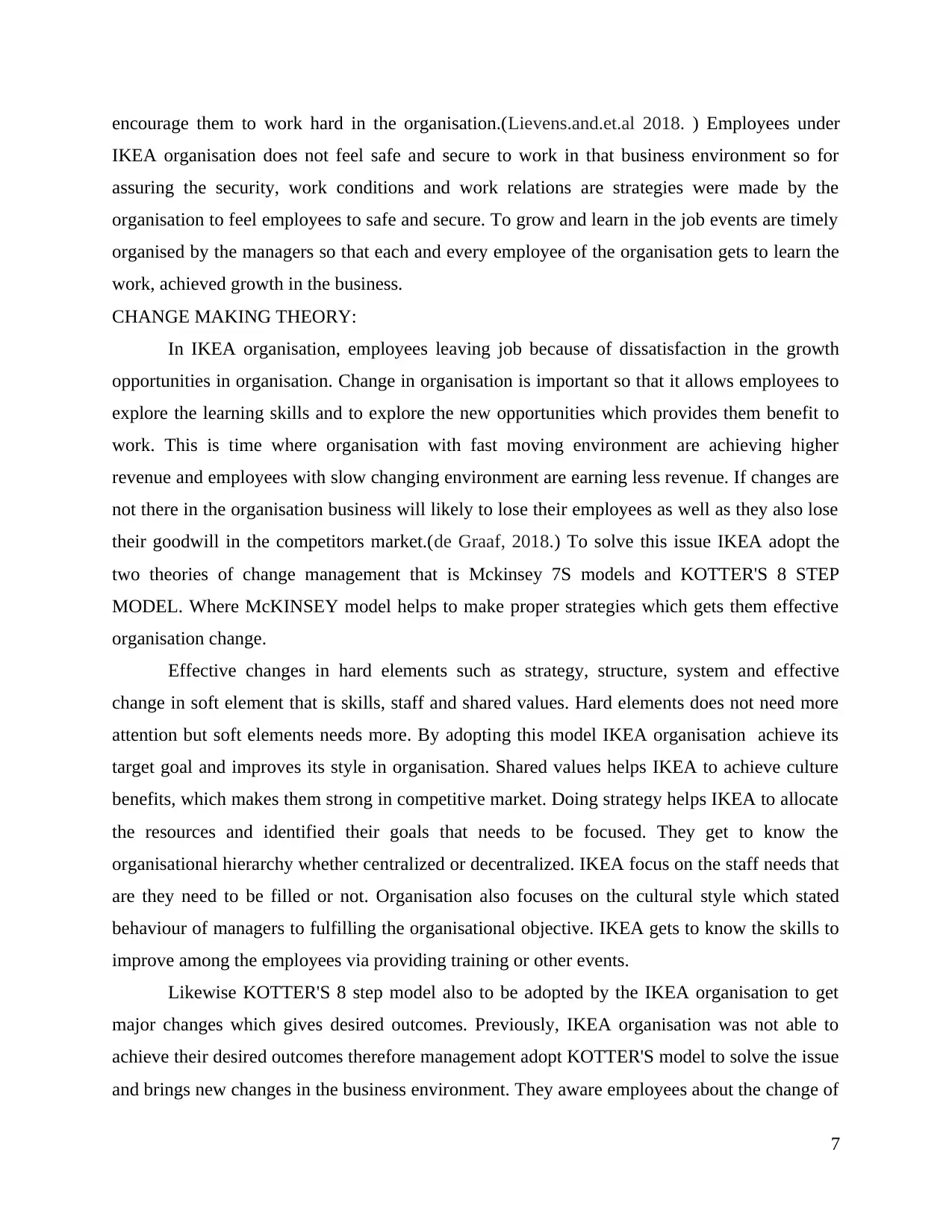
encourage them to work hard in the organisation.(Lievens.and.et.al 2018. ) Employees under
IKEA organisation does not feel safe and secure to work in that business environment so for
assuring the security, work conditions and work relations are strategies were made by the
organisation to feel employees to safe and secure. To grow and learn in the job events are timely
organised by the managers so that each and every employee of the organisation gets to learn the
work, achieved growth in the business.
CHANGE MAKING THEORY:
In IKEA organisation, employees leaving job because of dissatisfaction in the growth
opportunities in organisation. Change in organisation is important so that it allows employees to
explore the learning skills and to explore the new opportunities which provides them benefit to
work. This is time where organisation with fast moving environment are achieving higher
revenue and employees with slow changing environment are earning less revenue. If changes are
not there in the organisation business will likely to lose their employees as well as they also lose
their goodwill in the competitors market.(de Graaf, 2018.) To solve this issue IKEA adopt the
two theories of change management that is Mckinsey 7S models and KOTTER'S 8 STEP
MODEL. Where McKINSEY model helps to make proper strategies which gets them effective
organisation change.
Effective changes in hard elements such as strategy, structure, system and effective
change in soft element that is skills, staff and shared values. Hard elements does not need more
attention but soft elements needs more. By adopting this model IKEA organisation achieve its
target goal and improves its style in organisation. Shared values helps IKEA to achieve culture
benefits, which makes them strong in competitive market. Doing strategy helps IKEA to allocate
the resources and identified their goals that needs to be focused. They get to know the
organisational hierarchy whether centralized or decentralized. IKEA focus on the staff needs that
are they need to be filled or not. Organisation also focuses on the cultural style which stated
behaviour of managers to fulfilling the organisational objective. IKEA gets to know the skills to
improve among the employees via providing training or other events.
Likewise KOTTER'S 8 step model also to be adopted by the IKEA organisation to get
major changes which gives desired outcomes. Previously, IKEA organisation was not able to
achieve their desired outcomes therefore management adopt KOTTER'S model to solve the issue
and brings new changes in the business environment. They aware employees about the change of
7
IKEA organisation does not feel safe and secure to work in that business environment so for
assuring the security, work conditions and work relations are strategies were made by the
organisation to feel employees to safe and secure. To grow and learn in the job events are timely
organised by the managers so that each and every employee of the organisation gets to learn the
work, achieved growth in the business.
CHANGE MAKING THEORY:
In IKEA organisation, employees leaving job because of dissatisfaction in the growth
opportunities in organisation. Change in organisation is important so that it allows employees to
explore the learning skills and to explore the new opportunities which provides them benefit to
work. This is time where organisation with fast moving environment are achieving higher
revenue and employees with slow changing environment are earning less revenue. If changes are
not there in the organisation business will likely to lose their employees as well as they also lose
their goodwill in the competitors market.(de Graaf, 2018.) To solve this issue IKEA adopt the
two theories of change management that is Mckinsey 7S models and KOTTER'S 8 STEP
MODEL. Where McKINSEY model helps to make proper strategies which gets them effective
organisation change.
Effective changes in hard elements such as strategy, structure, system and effective
change in soft element that is skills, staff and shared values. Hard elements does not need more
attention but soft elements needs more. By adopting this model IKEA organisation achieve its
target goal and improves its style in organisation. Shared values helps IKEA to achieve culture
benefits, which makes them strong in competitive market. Doing strategy helps IKEA to allocate
the resources and identified their goals that needs to be focused. They get to know the
organisational hierarchy whether centralized or decentralized. IKEA focus on the staff needs that
are they need to be filled or not. Organisation also focuses on the cultural style which stated
behaviour of managers to fulfilling the organisational objective. IKEA gets to know the skills to
improve among the employees via providing training or other events.
Likewise KOTTER'S 8 step model also to be adopted by the IKEA organisation to get
major changes which gives desired outcomes. Previously, IKEA organisation was not able to
achieve their desired outcomes therefore management adopt KOTTER'S model to solve the issue
and brings new changes in the business environment. They aware employees about the change of
7
⊘ This is a preview!⊘
Do you want full access?
Subscribe today to unlock all pages.

Trusted by 1+ million students worldwide
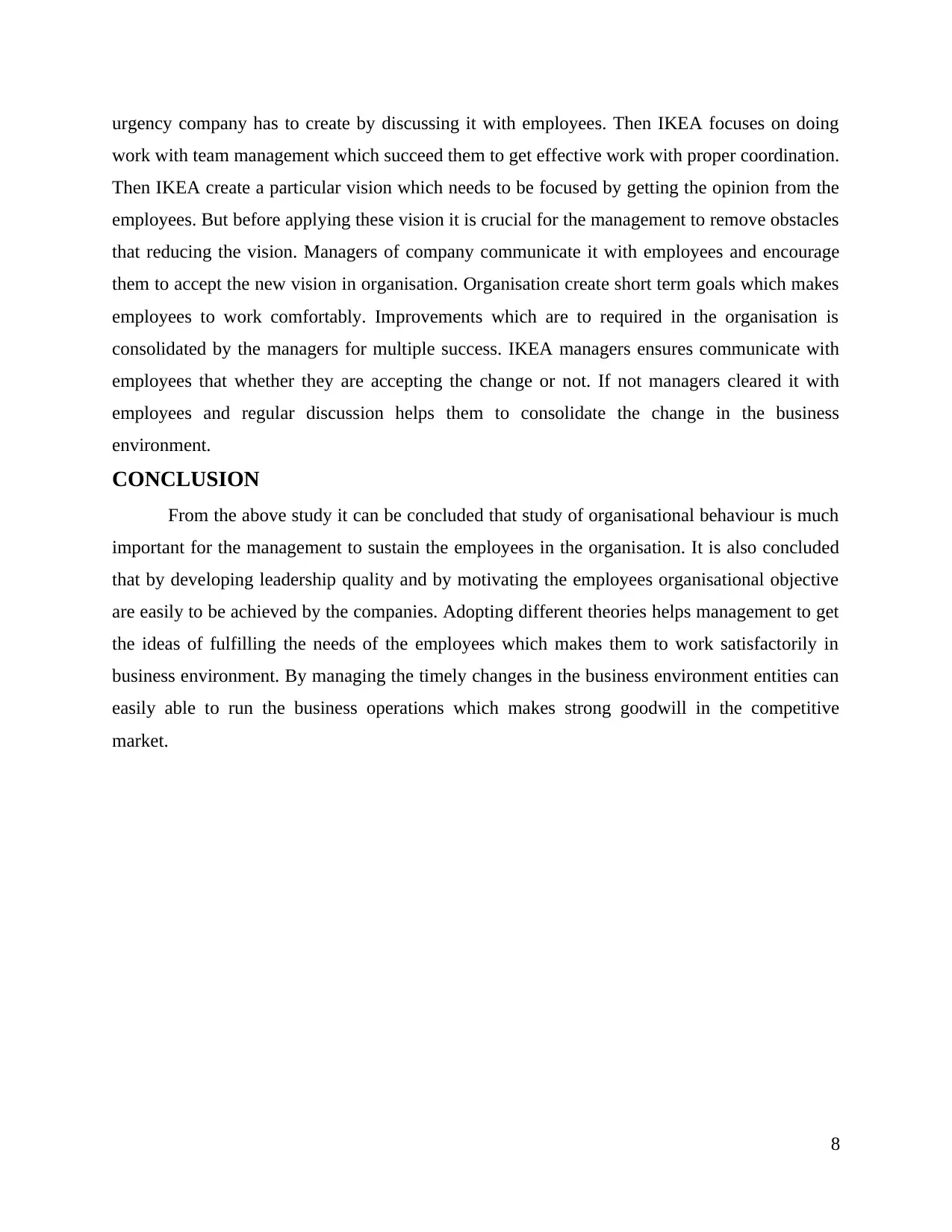
urgency company has to create by discussing it with employees. Then IKEA focuses on doing
work with team management which succeed them to get effective work with proper coordination.
Then IKEA create a particular vision which needs to be focused by getting the opinion from the
employees. But before applying these vision it is crucial for the management to remove obstacles
that reducing the vision. Managers of company communicate it with employees and encourage
them to accept the new vision in organisation. Organisation create short term goals which makes
employees to work comfortably. Improvements which are to required in the organisation is
consolidated by the managers for multiple success. IKEA managers ensures communicate with
employees that whether they are accepting the change or not. If not managers cleared it with
employees and regular discussion helps them to consolidate the change in the business
environment.
CONCLUSION
From the above study it can be concluded that study of organisational behaviour is much
important for the management to sustain the employees in the organisation. It is also concluded
that by developing leadership quality and by motivating the employees organisational objective
are easily to be achieved by the companies. Adopting different theories helps management to get
the ideas of fulfilling the needs of the employees which makes them to work satisfactorily in
business environment. By managing the timely changes in the business environment entities can
easily able to run the business operations which makes strong goodwill in the competitive
market.
8
work with team management which succeed them to get effective work with proper coordination.
Then IKEA create a particular vision which needs to be focused by getting the opinion from the
employees. But before applying these vision it is crucial for the management to remove obstacles
that reducing the vision. Managers of company communicate it with employees and encourage
them to accept the new vision in organisation. Organisation create short term goals which makes
employees to work comfortably. Improvements which are to required in the organisation is
consolidated by the managers for multiple success. IKEA managers ensures communicate with
employees that whether they are accepting the change or not. If not managers cleared it with
employees and regular discussion helps them to consolidate the change in the business
environment.
CONCLUSION
From the above study it can be concluded that study of organisational behaviour is much
important for the management to sustain the employees in the organisation. It is also concluded
that by developing leadership quality and by motivating the employees organisational objective
are easily to be achieved by the companies. Adopting different theories helps management to get
the ideas of fulfilling the needs of the employees which makes them to work satisfactorily in
business environment. By managing the timely changes in the business environment entities can
easily able to run the business operations which makes strong goodwill in the competitive
market.
8
Paraphrase This Document
Need a fresh take? Get an instant paraphrase of this document with our AI Paraphraser
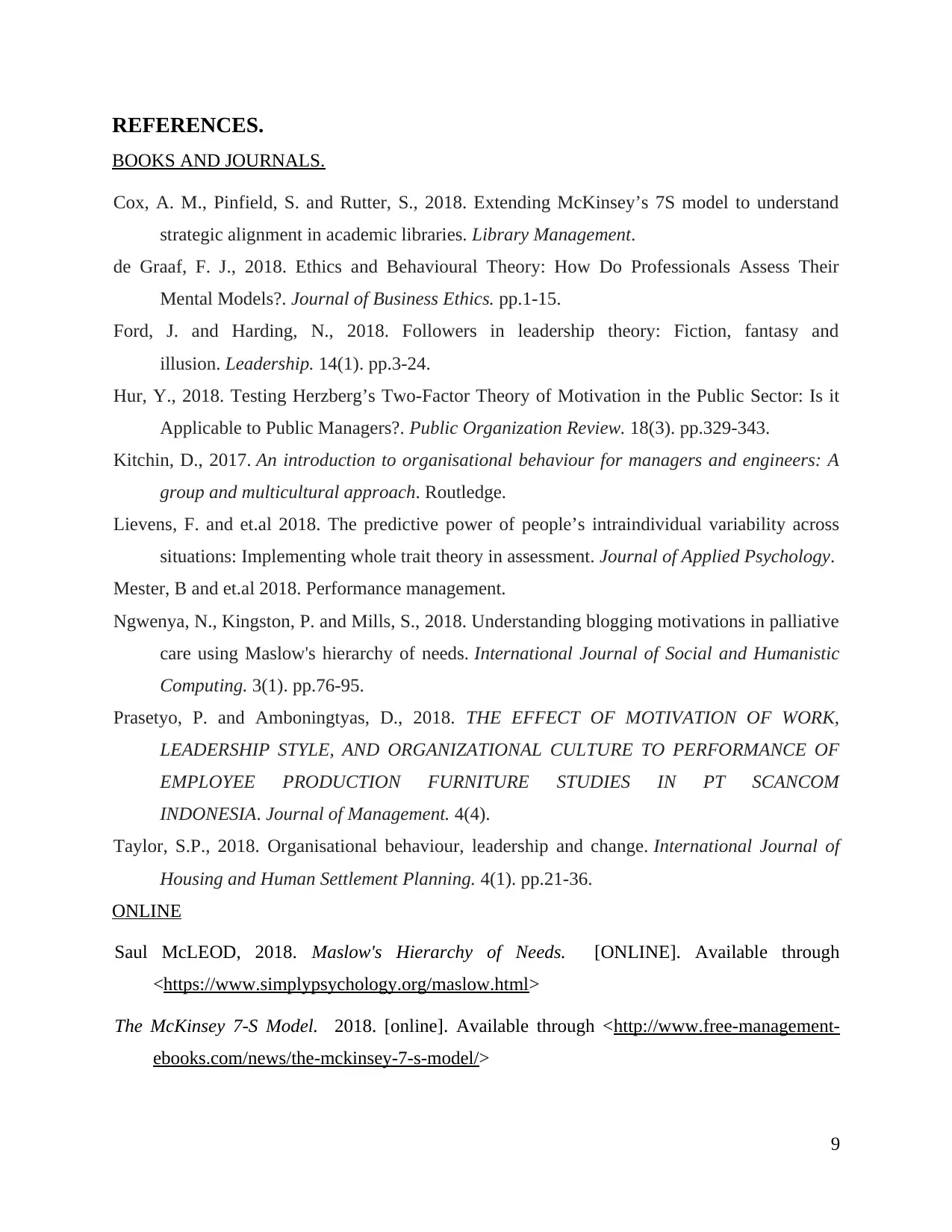
REFERENCES.
BOOKS AND JOURNALS.
Cox, A. M., Pinfield, S. and Rutter, S., 2018. Extending McKinsey’s 7S model to understand
strategic alignment in academic libraries. Library Management.
de Graaf, F. J., 2018. Ethics and Behavioural Theory: How Do Professionals Assess Their
Mental Models?. Journal of Business Ethics. pp.1-15.
Ford, J. and Harding, N., 2018. Followers in leadership theory: Fiction, fantasy and
illusion. Leadership. 14(1). pp.3-24.
Hur, Y., 2018. Testing Herzberg’s Two-Factor Theory of Motivation in the Public Sector: Is it
Applicable to Public Managers?. Public Organization Review. 18(3). pp.329-343.
Kitchin, D., 2017. An introduction to organisational behaviour for managers and engineers: A
group and multicultural approach. Routledge.
Lievens, F. and et.al 2018. The predictive power of people’s intraindividual variability across
situations: Implementing whole trait theory in assessment. Journal of Applied Psychology.
Mester, B and et.al 2018. Performance management.
Ngwenya, N., Kingston, P. and Mills, S., 2018. Understanding blogging motivations in palliative
care using Maslow's hierarchy of needs. International Journal of Social and Humanistic
Computing. 3(1). pp.76-95.
Prasetyo, P. and Amboningtyas, D., 2018. THE EFFECT OF MOTIVATION OF WORK,
LEADERSHIP STYLE, AND ORGANIZATIONAL CULTURE TO PERFORMANCE OF
EMPLOYEE PRODUCTION FURNITURE STUDIES IN PT SCANCOM
INDONESIA. Journal of Management. 4(4).
Taylor, S.P., 2018. Organisational behaviour, leadership and change. International Journal of
Housing and Human Settlement Planning. 4(1). pp.21-36.
ONLINE
Saul McLEOD, 2018. Maslow's Hierarchy of Needs. [ONLINE]. Available through
<https://www.simplypsychology.org/maslow.html>
The McKinsey 7-S Model. 2018. [online]. Available through <http://www.free-management-
ebooks.com/news/the-mckinsey-7-s-model/>
9
BOOKS AND JOURNALS.
Cox, A. M., Pinfield, S. and Rutter, S., 2018. Extending McKinsey’s 7S model to understand
strategic alignment in academic libraries. Library Management.
de Graaf, F. J., 2018. Ethics and Behavioural Theory: How Do Professionals Assess Their
Mental Models?. Journal of Business Ethics. pp.1-15.
Ford, J. and Harding, N., 2018. Followers in leadership theory: Fiction, fantasy and
illusion. Leadership. 14(1). pp.3-24.
Hur, Y., 2018. Testing Herzberg’s Two-Factor Theory of Motivation in the Public Sector: Is it
Applicable to Public Managers?. Public Organization Review. 18(3). pp.329-343.
Kitchin, D., 2017. An introduction to organisational behaviour for managers and engineers: A
group and multicultural approach. Routledge.
Lievens, F. and et.al 2018. The predictive power of people’s intraindividual variability across
situations: Implementing whole trait theory in assessment. Journal of Applied Psychology.
Mester, B and et.al 2018. Performance management.
Ngwenya, N., Kingston, P. and Mills, S., 2018. Understanding blogging motivations in palliative
care using Maslow's hierarchy of needs. International Journal of Social and Humanistic
Computing. 3(1). pp.76-95.
Prasetyo, P. and Amboningtyas, D., 2018. THE EFFECT OF MOTIVATION OF WORK,
LEADERSHIP STYLE, AND ORGANIZATIONAL CULTURE TO PERFORMANCE OF
EMPLOYEE PRODUCTION FURNITURE STUDIES IN PT SCANCOM
INDONESIA. Journal of Management. 4(4).
Taylor, S.P., 2018. Organisational behaviour, leadership and change. International Journal of
Housing and Human Settlement Planning. 4(1). pp.21-36.
ONLINE
Saul McLEOD, 2018. Maslow's Hierarchy of Needs. [ONLINE]. Available through
<https://www.simplypsychology.org/maslow.html>
The McKinsey 7-S Model. 2018. [online]. Available through <http://www.free-management-
ebooks.com/news/the-mckinsey-7-s-model/>
9
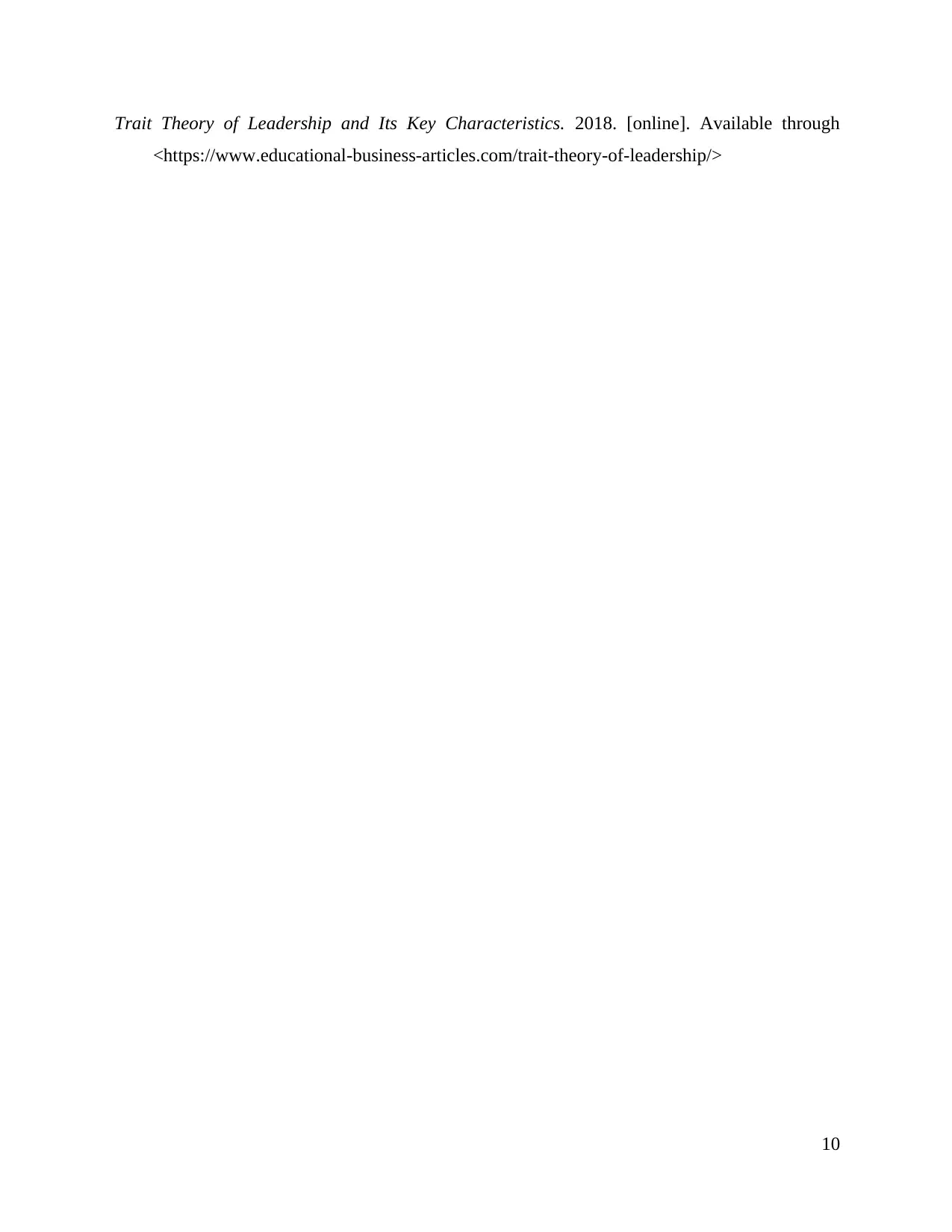
Trait Theory of Leadership and Its Key Characteristics. 2018. [online]. Available through
<https://www.educational-business-articles.com/trait-theory-of-leadership/>
10
<https://www.educational-business-articles.com/trait-theory-of-leadership/>
10
⊘ This is a preview!⊘
Do you want full access?
Subscribe today to unlock all pages.

Trusted by 1+ million students worldwide
1 out of 12
Related Documents
Your All-in-One AI-Powered Toolkit for Academic Success.
+13062052269
info@desklib.com
Available 24*7 on WhatsApp / Email
![[object Object]](/_next/static/media/star-bottom.7253800d.svg)
Unlock your academic potential
Copyright © 2020–2025 A2Z Services. All Rights Reserved. Developed and managed by ZUCOL.




